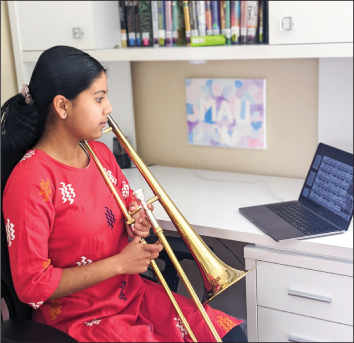Encouraging traditional outfits is one way schools help students express their identity
By Mugdha Shinde, California
The first time i wore an Indian dress to school was in fourth grade. We were doing a biography project and were required to dress up as the person we had chosen. In my case, that was the famous Indian classical singer, Asha Bhosle, a sister to the even more famous singer, Lata Mangeshkar. I wore a “half sari” because Asha is from Maharashtra, as is my family, and this sari is a traditional dress there. It was a great experience. Everyone was dressed up, so I did not stand out much in the class.

Most people had chosen to do biographies about people from the United States. I was one of the few who chose someone from outside North America. I received questions both inside and outside the class and got to tell people who Asha Bhosle was, and about all the great songs she has sung. None of the questions were negative, and everyone was happy that I had chosen to wear something unique. I had worried that the sari would be too restricting, but I could do all school activities in it, including physical education class. Overall, I really liked wearing the outfit.
In fifth grade, I was inspired to wear a Punjabi dress to school on Vijayadashami. It wasn’t a class assignment, but my choice. I told people about the festival, and how it celebrates the defeat of Ravana by Rama. Kids and teachers all wished me “Happy Vijayadashami” and complimented my outfit. The experience was more fun than the 4th-grade one because I was the only one dressed up. I also dressed up for Holi and Diwali. Most people knew about Diwali, and so when they saw me and other students in Indian dresses, they wished us “Happy Diwali.” On a few days, I dressed up just for fun.
The next year, I entered middle school where they hold an annual cultural day where students can choose to dress up in their traditional clothes, or dance or sing. It’s optional, and participation is not mandatory. In sixth grade, this event was held in the evening, so that parents could attend. There were students from the Chinese, Japanese, Indian, Mexican, Korean and Jewish cultures.
I asked one of the Korean students, Claire Lee, why she wanted to participate. She said, “I chose to because I knew that K-pop was getting more popular in countries like America, but people hadn’t seen much of the traditional side of Korean performances. At first, I was skeptical about performing because I didn’t think anyone would enjoy watching our traditional dancing. But I wanted people to know more about Korean culture. Surprisingly (to me at least), barely anyone asked questions. At the end, I felt good about representing my country with dancing, even if not everyone enjoyed it.”
Around a third of the students participated in this cultural day, including a few Indians. Due to the event being in the evening, many students couldn’t make it because of conflicting classes or activities. Unfortunately, I had volleyball tryouts before the event, and could not go home and change into a traditional dress. I came in normal clothes, and tried to support the students who were dressed up. The only stage presentation for India was a Bollywood dance. To me, Bollywood is only one part of the vast culture of India, and is not a good representation of India by itself.
The last time I got to wear an Indian dress to school before the pandemic started was for a Spirit Day in sixth grade. At my school, students can choose to show their school spirit by participating in lunchtime activities on Fridays. On this particular Spirit Day, the theme was to dress up as a character. Most kids dressed up as movie characters, but I dressed up as a proud Indian person. Some of my friends complimented me on my outfit. I was pleased to see that other Indian students have started representing their cultures, including at our school’s talent show, where there were two Indian/Nepalese dancers.
It was a fun experience every time I wore an Indian dress to school, and that might have something to do with my living in Silicon Valley, a very diverse area. Dressing up differently here is not as unusual as in a less diverse place, such as Iowa. It might be hard to introduce Hindu culture to a less diverse community. However, it is worth the stares and questions if dressing up in traditional clothes means that word is spread about Hinduism.
In the future, I hope that more people will be encouraged to go to school, stores and public events dressed up in traditional clothes. People such as Claire Lee have started doing this, and her experience has inspired me to participate in our school’s talent show this fall, hopefully when life gets back to normal.
Mugdha Shinde, 13, is an eighth-grade student at Cupertino Middle School in Cupertino, California. She plays the trombone in her school’s advanced band, and enjoys cooking and baking. mugdha.shinde29@gmail.com
